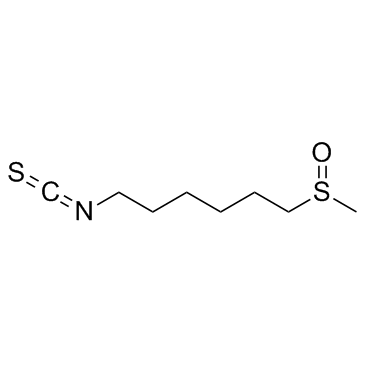6-Methylsulfinylhexyl Isothiocyanate
Modify Date: 2025-08-25 23:21:33

6-Methylsulfinylhexyl Isothiocyanate structure
|
Common Name | 6-Methylsulfinylhexyl Isothiocyanate | ||
|---|---|---|---|---|
| CAS Number | 4430-35-7 | Molecular Weight | 205.34100 | |
| Density | N/A | Boiling Point | N/A | |
| Molecular Formula | C8H15NOS2 | Melting Point | N/A | |
| MSDS | N/A | Flash Point | N/A | |
Use of 6-Methylsulfinylhexyl IsothiocyanateHesperin is a bioactive ingredient present in Japanese horseradish (wasabi) and has been shown to be an Nrf2 activator. |
| Name | 1-isothiocyanato-6-methylsulfinylhexane |
|---|---|
| Synonym | More Synonyms |
| Description | Hesperin is a bioactive ingredient present in Japanese horseradish (wasabi) and has been shown to be an Nrf2 activator. |
|---|---|
| Related Catalog | |
| Target |
Nrf2[1] |
| In Vitro | Hesperin (6-Methylsulfinylhexyl isothiocyanate, 6-MSITC) is an active compound in wasabi (Wasabia japonica Matsum.). Whether Hesperin induces cytotoxicity of HUVECs is determined. More than 1 μg/mL of Hesperin markedly induces cytotoxicity and morphological alterations. In subsequent experiments we used Hesperin is used at concentrations of 0-1 μg/mL, to study the anti-coagulant and anti-inflammatory properties of Hesperin in HUVECs[2]. |
| In Vivo | Hesperin (6-Methylsulfinylhexyl isothiocyanate, 6-MSITC) activates Nrf2 and induces phase II enzyme genes but this induction is absent in Nrf2-null mice, suggesting that Hesperin is a potential activator of the Nrf2/ARE-dependent detoxification pathway. To determine whether Hesperin ameliorates hepatic steatosis and iron accumulation, wild-type and Nrf2-null mice are fed the following diets for 12 weeks: 1) control diet, 2) high-fat diet (HFD), 3) HFD plus Hesperin (10 mg/kg/day ip), 4) HFD for 6 weeks followed by an iron-supplemented HFD for 6 weeks (HFD/Iron), 5) HFD/Iron plus Hesperin. The HFD increased hepatic triglycerides in both genotypes and Hesperin suppress increased hepatic triglycerides in wild-type mice but do not reduce thesetriglycerides in Nrf2-null mice[1]. |
| Cell Assay | Primary human umbilical vein endothelial cells (HUVECs) are cultured in collagen-coated tissue-culture dishes in an atmosphere containing 95 % air and 5 % CO2. Human monoblast U937 cells are grown in RPMI-1640 medium with 10 % fetal bovine serum, 10 U/mL Penicillin, and 10μg/mL Streptomycin. HUVECs are cultured in collagen-coated 96-well plates as confluent monolayers. Hesperin is added into wells at the indicated final concentrations (0-30 μg/mL) and then incubated for 24 h. Cell viability is measured by cell counting kits[2]. |
| Animal Admin | Mice[1]A colony of wild-type and Nrf2-null mice are backcrossed with C57BL/6 mice for ten generations. All mice are housed in the same animal care facility controlled for temperature, humidity, and light. Seven-week-old male wild-typeand Nrf2-null mice (n=6-8/group) are divided into five groups fed the following diets: 1) a standard diet (AIN-93, containing 4% soybean oil) for 12 weeks and vehicle (1:10 solution of DMSO/PBS) injected intraperitoneally 4 times per week for the last four weeks (control group), 2) a high-fat diet (HFD) (containing 4% soybean oil and 31% lard) for 12 weeks and vehicle injected intraperitoneally 4 times per week for the last four weeks (HFD group),3) a HFD for 12 weeks and Hesperin (10mg/Kg/day; dissolved in 1:10 solution of DMSO/PBS) injected intraperitoneally 4 times per week for the last four weeks (HFD+ Hesperin), 4) a HFD for 6 weeks followed by a HFD containing 1% carbonyl iron for 6 weeks and vehicle injected intraperitoneally 4 times per week for the last four weeks(HFD+Iron), and 5) a HFD for 6 weeks followed by a HFD containing 1% carbonyl iron for 6 weeks and Hesperin (10mg/Kg/day) injected intraperitoneally 4 times per week for the last four weeks (HFD+Iron+Hesperin). After 12 weeks, blood samples are collected by cardiac puncture under anesthesia with sodium pentobarbital (50 mg/kg, ip) and livers are harvested and stored at -80°C until analysis[1]. |
| References |
| Molecular Formula | C8H15NOS2 |
|---|---|
| Molecular Weight | 205.34100 |
| Exact Mass | 205.06000 |
| PSA | 80.73000 |
| LogP | 2.89380 |
| InChIKey | XQZVZULJKVALRI-UHFFFAOYSA-N |
| SMILES | CS(=O)CCCCCCN=C=S |
| Storage condition | 2-8℃ |
| HS Code | 2930909090 |
|---|
|
~% 
6-Methylsulfiny... CAS#:4430-35-7 |
| Literature: Etoh, Hideo; Nishimura, Akiyoshi; Takasawa, Reiko; Yagi, Akihito; Saito, Kazuhide; et al. Agricultural and Biological Chemistry, 1990 , vol. 54, # 6 p. 1587 - 1589 |
| Precursor 1 | |
|---|---|
| DownStream 0 | |
| HS Code | 2930909090 |
|---|---|
| Summary | 2930909090. other organo-sulphur compounds. VAT:17.0%. Tax rebate rate:13.0%. . MFN tariff:6.5%. General tariff:30.0% |
| 6-Methylsulfinylhexyl Isothiocyanate |
| Hesperin |
